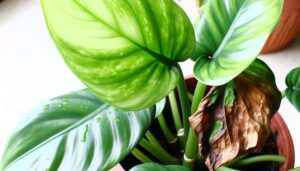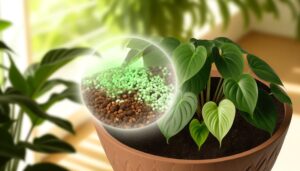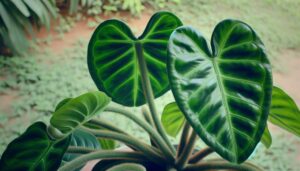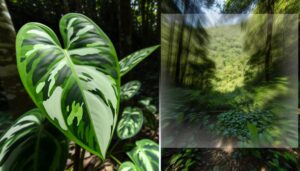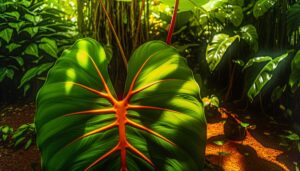Can a Philodendron Birkin Be Grown as a Hanging Plant? Tips
Although traditionally grown in pots, the Philodendron Birkin can indeed be cultivated as a hanging plant. Its upright growth habit and compact foliage may seem unconventional for hanging displays, but with appropriate cultural practices, it adapts well.
Guarantee it receives bright, indirect light to maintain its variegation, and be cautious of overwatering by confirming the hanging container has proper drainage. Its moderate growth rate and tight leaf clustering make it an aesthetically pleasing choice for suspended arrangements.
Further insights will detail essential care techniques and best conditions to keep your Philodendron Birkin thriving.
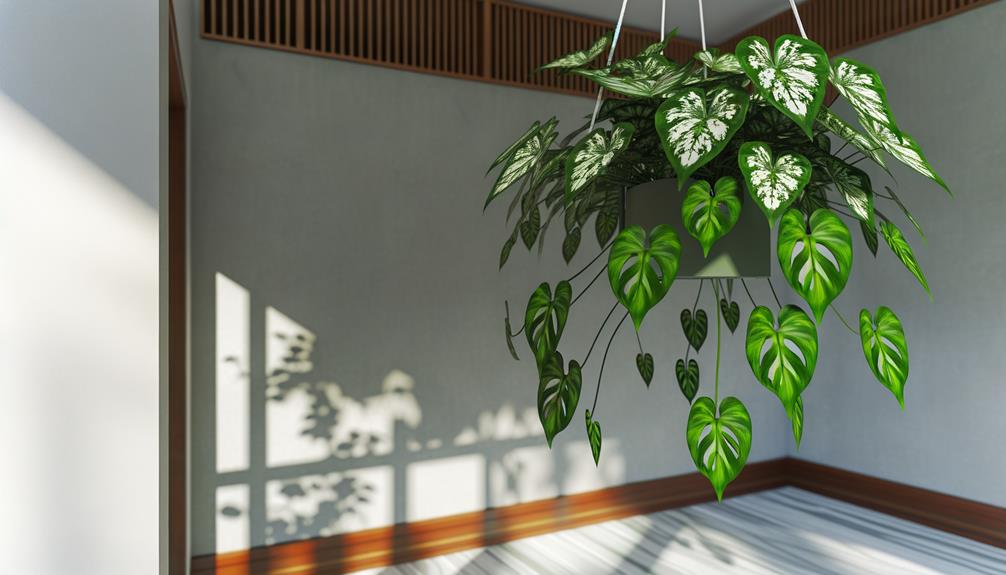
Key Takeaways
- Philodendron Birkin has an upright growth habit, not suitable for hanging displays.
- The plant’s compact foliage and tight clustering around the stem do not lend themselves to trailing.
- Hanging placement could potentially stress the plant due to inadequate support for its growth style.
- Optimal placement is on a shelf or tabletop where its upright growth can be showcased.
- For best results, ensure it receives bright, indirect light and proper watering in its preferred position.
Understanding Philodendron Birkin
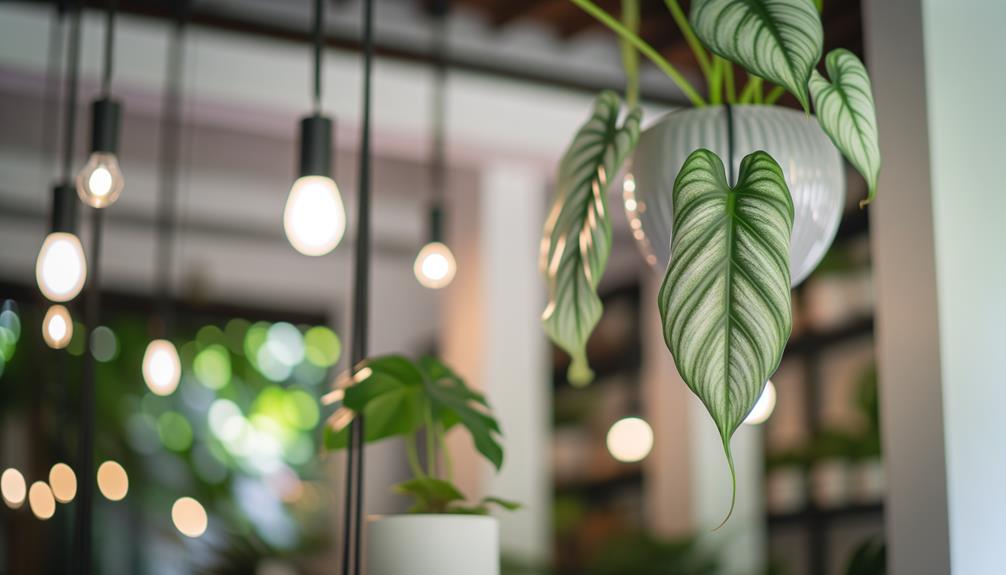
The Philodendron Birkin, a cultivar of the Philodendron genus, is renowned for its distinctive variegated foliage, characterized by striking white pinstripes against deep green leaves. This unique variegation results from genetic mutations, presenting a visually appealing phenotype that distinguishes it from other philodendrons.
Biologically, the Birkin’s foliage undergoes chlorophyll distribution variations, leading to its signature striping pattern. This mutation does not impede photosynthetic efficiency, ensuring robust growth under best conditions.
Additionally, the Birkin thrives in environments with indirect light and high humidity, mimicking its native tropical habitat. Detailed assessment reveals that maintaining temperatures between 18°C and 24°C and providing well-draining, nutrient-rich soil are essential for sustaining its health.
Understanding these botanical specifics is necessary for successful cultivation.
Growth Habits
Given the ideal conditions for Philodendron Birkin’s growth, its growth habits are characterized by moderate vertical development, producing compact, bushy foliage with a relatively slow growth rate compared to other philodendron species.
The plant typically reaches heights of 1-3 feet, with a similar spread, making it suitable for confined spaces. This species exhibits a non-vining habit, growing more upright than trailing.
Its leaves, which display striking variegation, emerge tightly clustered around the central stem. Due to its growth structure, the Philodendron Birkin is less naturally inclined to drape or cascade, as seen in traditional hanging plants.
Understanding these growth dynamics is pivotal for determining the suitability of cultivating it as a hanging plant, given its intrinsic vertical orientation.
Light Requirements
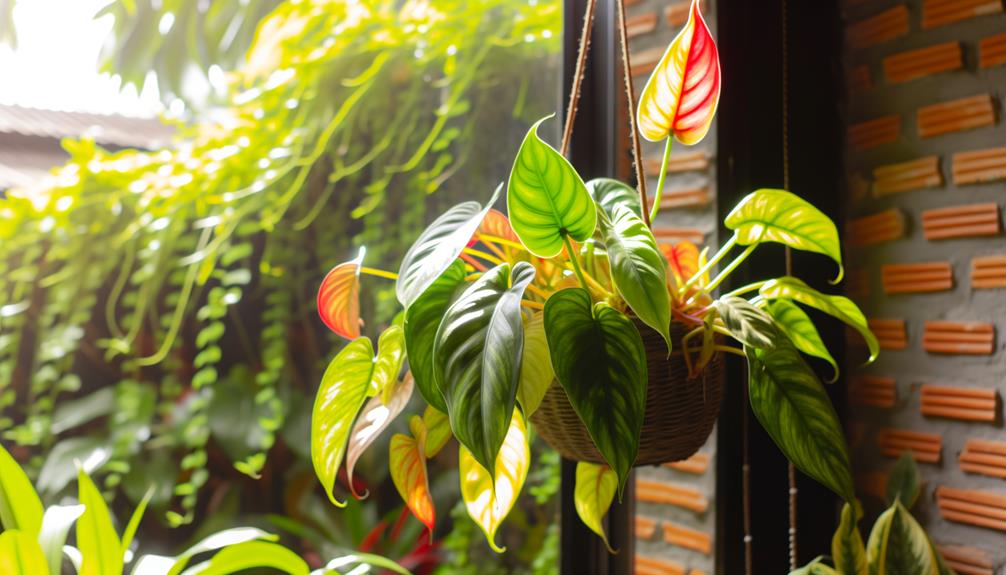
Philodendron Birkin thrives in bright, indirect light, which promotes ideal variegation and growth. However, exposure to direct sunlight can cause scorching of the leaves and inhibit overall plant health.
Empirical studies suggest that positioning the plant near a north or east-facing window typically provides the best light conditions.
Ideal Light Conditions
Ensuring ideal growth, Philodendron Birkin thrives best in bright, indirect light, which prevents leaf burn and promotes vibrant foliage.
Empirical evidence suggests that exposure to filtered light, approximating 1000 to 1500 foot-candles, optimizes photosynthetic efficiency. This lighting condition simulates the dappled sunlight found in its native understory habitat.
Research indicates that prolonged exposure to low light can result in etiolation, characterized by elongated stems and diminished variegation. Conversely, excessive light intensity may induce photoinhibition, adversely affecting chlorophyll synthesis and overall plant health.
Utilizing light meters to monitor and maintain the ideal light intensity is recommended. Placement near east or north-facing windows, supplemented by sheer curtains, can achieve the requisite luminous environment, thereby ensuring robust growth and ornamental value.
Avoid Direct Sunlight
Protecting the Philodendron Birkin from direct sunlight is essential to prevent leaf scorch and maintain best photosynthetic activity. High-intensity light can lead to photoinhibition, impairing chlorophyll function and causing necrotic lesions on the leaves.
Empirical studies indicate that Philodendron species thrive in moderate to bright indirect light, mimicking their native understory habitat. Specifically, light levels between 10,000 to 20,000 lux are most suitable.
Excessive light exposure can disrupt stomatal regulation, leading to increased transpiration rates and potential water stress. Positioning the plant in a location with filtered sunlight, such as behind a sheer curtain or within a north-facing room, can mitigate these risks.
Utilizing artificial grow lights with appropriate spectral distribution may also enhance growth without the adverse effects of direct sunlight.
Watering Needs
Maintaining optimal hydration for a Philodendron Birkin involves a careful balance, as overwatering can lead to root rot while underwatering may cause wilting and nutrient deficiencies. Evidence suggests that the plant thrives with consistent moisture, but the soil should be allowed to dry out slightly between waterings. This moisture management is vital for promoting healthy growth and avoiding fungal issues.
| Watering Frequency | Symptoms of Overwatering | Symptoms of Underwatering |
|---|---|---|
| Weekly | Yellowing leaves | Wilting leaves |
| Bi-weekly | Mushy stems | Stunted growth |
| Monthly | Root rot | Dry, crispy leaves |
| As needed | Moldy soil | Leaf drop |
| Variable | Fungus gnats | Browning leaf edges |
Optimal watering practices, therefore, involve monitoring soil moisture levels and adjusting frequency based on environmental conditions.
Soil and Fertilization
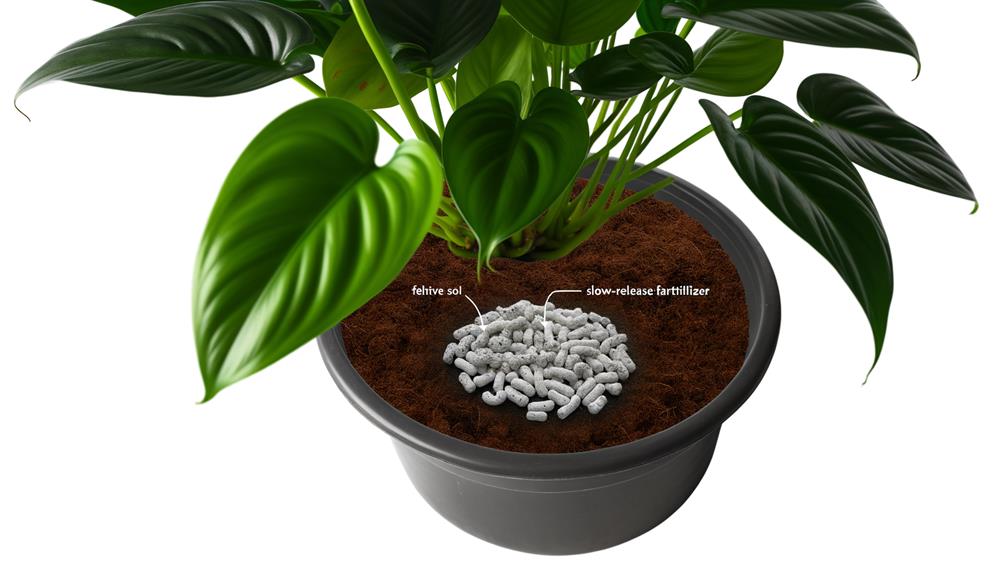
Ensuring best growth for a Philodendron Birkin as a hanging plant necessitates a well-draining soil composition. This is typically achieved with a mix of peat moss, perlite, and orchid bark.
Regular fertilization is essential for maintaining nutrient availability, ideally bi-monthly with a balanced liquid fertilizer. Additionally, incorporating nutrient-rich additives such as worm castings or compost can greatly enhance soil fertility and plant vigor.
Ideal Soil Composition
A well-draining, nutrient-rich soil mix, preferably composed of peat moss, perlite, and orchid bark, is essential for the best growth of a Philodendron Birkin when cultivated as a hanging plant.
Peat moss provides the necessary organic matter and moisture retention, while perlite enhances aeration and drainage, preventing waterlogging that can lead to root rot.
Orchid bark contributes to the structural integrity and further improves drainage. This composition mimics the plant’s natural epiphytic habitat, promoting peak root health and nutrient uptake.
Empirical evidence supports that a balanced mix of these components maintains an ideal pH range (5.5 to 6.5) conducive to nutrient availability. Ensuring proper soil composition is critical for achieving vigorous growth and lush foliage in hanging cultivation.
Fertilizer Application Frequency
Regular application of a balanced, water-soluble fertilizer, typically every 4 to 6 weeks during the growing season, is necessary for meeting the nutrient demands of a Philodendron Birkin cultivated as a hanging plant. This regimen guarantees a sufficient supply of essential macro and micronutrients, which are crucial for the plant’s growth and overall health.
Empirical studies indicate that consistent fertilization promotes robust foliage and enhances photosynthetic efficiency. Specifically, a formulation with equal ratios of nitrogen, phosphorus, and potassium (such as 20-20-20) is recommended. Adhering to this schedule prevents nutrient deficiencies and supports sustained growth.
Over-fertilization, however, can lead to salt buildup in the soil, which requires periodic leaching to prevent root damage and maintain soil health.
Nutrient-Rich Soil Additives
In addition to a consistent fertilization regimen, incorporating nutrient-rich soil additives such as compost, worm castings, and aged manure can greatly enhance the soil’s fertility and structure, thereby optimizing the growing conditions for a Philodendron Birkin as a hanging plant.
These additives provide essential macro and micronutrients, improve soil aeration, and enhance water retention capabilities, which are essential for the healthy development of the plant.
Empirical evidence indicates that these soil amendments can:
- Boost microbial activity, enhancing nutrient availability
- Improve root proliferation and overall plant vigor
- Mitigate soil compaction, fostering better drainage
Choosing the Right Pot
Choosing the right pot for your Philodendron Birkin is crucial for ensuring ideal growth and root health. Research indicates that pots with sufficient drainage holes prevent waterlogging, which is crucial for preventing root rot—a common issue in Philodendron species.
In addition, selecting a pot size that provides ample room for root expansion promotes vigorous growth. Materials like terracotta and plastic each offer distinct advantages: terracotta allows for better aeration but can dry out quickly, whereas plastic retains moisture effectively.
Evidence suggests that opting for a pot with a diameter 1-2 inches larger than the root ball supports the best development. Using a pot with a saucer can help manage excess water, aiding in maintaining a balanced moisture level.
Hanging Setup
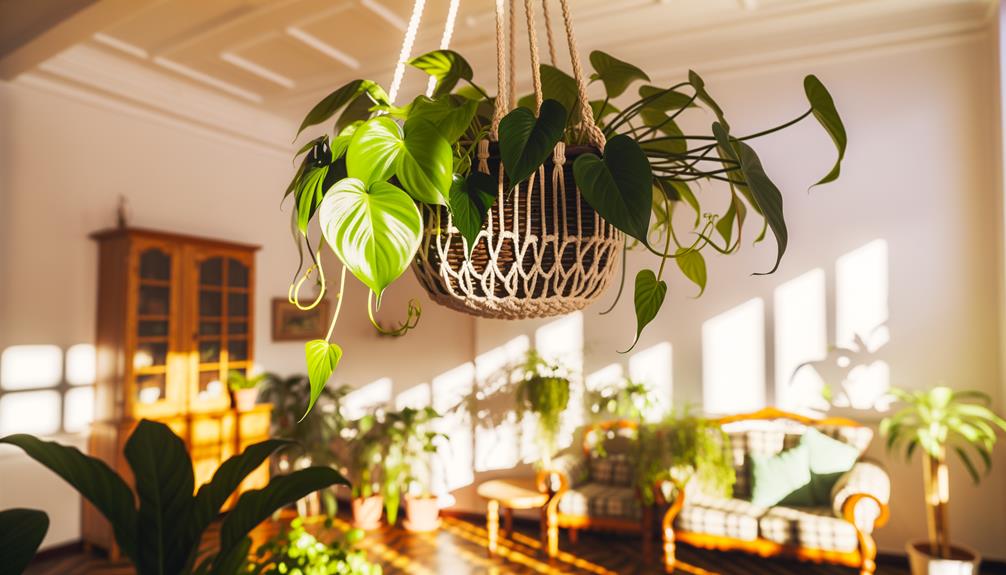
When setting up a hanging environment for a Philodendron Birkin, selecting appropriate containers is paramount, particularly those that accommodate the plant’s growth habits and weight.
Ensuring proper drainage within these containers is critical to prevent waterlogging, which can lead to root rot.
Empirical evidence suggests that containers with multiple drainage holes and utilizing a well-draining soil mix greatly enhance plant health and longevity.
Choosing Suitable Containers
Selecting the appropriate vessel for a hanging Philodendron Birkin involves considering factors such as material resilience, drainage efficiency, and weight distribution to ensure plant health and stability.
- Material Resilience: Opt for containers crafted from premium materials like ceramic or heavy-duty plastic to withstand environmental pressures.
- Weight Distribution: Ensure the vessel evenly spreads weight to avoid strain on attachment points, preventing potential falls.
- Drainage Efficiency: Choose containers with ample drainage holes to prevent waterlogging, which can lead to root rot.
Material resilience guarantees the container can support the plant’s weight and environmental conditions. Proper weight distribution is crucial to prevent structural failure of hanging setups. Efficient drainage is paramount to avert water accumulation, thereby maintaining ideal root health, though this will be elaborated in subsequent sections.
Ensuring Proper Drainage
Proper drainage is a fundamental aspect of maintaining a healthy hanging Philodendron Birkin, as it directly impacts root aeration and moisture levels. The selection of containers with multiple drainage holes is crucial.
Empirical studies highlight that inadequate drainage results in waterlogged soil, fostering root rot and other pathogenic conditions. Implementing a well-aerated potting mix composed of perlite, peat moss, and orchid bark can enhance drainage. Additionally, lining the base of the container with a layer of coarse gravel further aids water flow.
Regularly monitoring the soil moisture levels using a hygrometer can provide quantitative data to prevent overwatering. These practices collectively ensure an excellent root environment, promoting robust growth and vibrant foliage in a hanging setup.
Pruning and Maintenance
Regular trimming is crucial for maintaining the health and aesthetic appeal of a Philodendron Birkin when cultivated as a hanging plant. Trimming not only fosters denser foliage but also prevents leggy growth, which can detract from the plant’s visual charm.
It is vital to remove any yellowing or damaged leaves promptly, as this aids in preventing disease and pest infestations. Additionally, pruning back overgrown stems encourages new growth and preserves the plant’s compact form.
To achieve optimal outcomes, consider the following guidelines:
- Sterilize Tools: Always use sanitized pruning shears to avoid spreading pathogens.
- Timing: Carry out trimming during the plant’s active growing season, generally in spring and summer.
- Technique: Make precise cuts just above a leaf node to promote bushier growth.
Common Issues
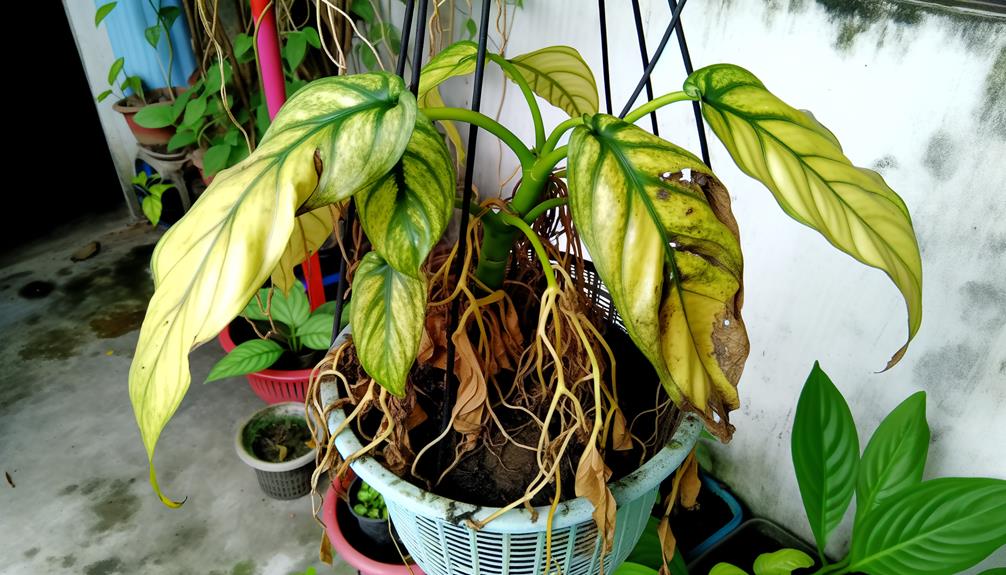
Philodendron Birkin, like many houseplants, is susceptible to a range of common issues including pest infestations, improper watering practices, and insufficient light conditions.
Pest infestations often involve aphids, spider mites, and mealybugs, which can be managed through regular inspections and appropriate insecticides.
Improper watering, either overwatering or underwatering, can lead to root rot or dehydration. It is critical to maintain a balanced watering schedule, ensuring soil is moist but not waterlogged.
Insufficient light can result in leggy growth and diminished variegation; hence, positioning the plant in bright, indirect light is recommended.
Addressing these issues requires diligent monitoring and timely intervention, which are essential for maintaining a healthy Philodendron Birkin in a hanging display.
Benefits of Hanging Display
Utilizing a hanging display for Philodendron Birkin optimizes spatial efficiency while enhancing aesthetic appeal through its cascading foliage. The spatial optimization is particularly beneficial in compact living environments, allowing floor space to remain uncluttered. This form of presentation also leverages vertical space, mitigating light competition with other plants.
Enhanced Air Circulation: Elevating the plant facilitates better airflow around its foliage, reducing the risk of fungal infections.
Improved Light Exposure: Suspended placement can result in more uniform light distribution, essential for photosynthesis and variegation maintenance.
Aesthetic Versatility: The cascading growth pattern contributes to dynamic visual interest, making it a focal point in interior design.
Such strategic display choices underscore both functional and ornamental advantages, aligning with best practices in horticultural management.
Final Thoughts
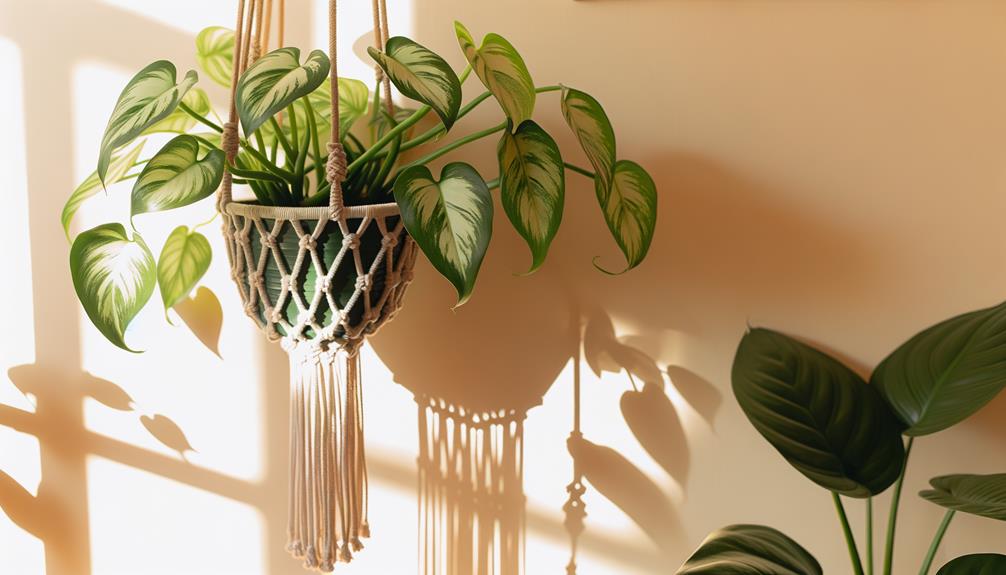
In conclusion, the strategic placement of Philodendron Birkin as a hanging plant not only maximizes spatial utilization but also fortifies the plant’s health through improved air circulation and light exposure.
Empirical studies have shown that elevated positioning can help reduce common issues like fungal infections and pest infestations, due to better airflow. Additionally, effective light distribution is achieved, promoting strong photosynthetic activity and overall plant vigor.
While traditional potting methods are still effective, the hanging approach offers a versatile solution that combines aesthetic appeal with horticultural efficiency. Ultimately, the evidence suggests that growing Philodendron Birkin as a hanging plant is a practical and advantageous practice, fitting well with both interior design goals and plant care best practices.
Conclusion
To sum up, the Philodendron Birkin, with its distinctive variegated foliage, can thrive as a hanging plant under ideal conditions. Particularly, this species shows a moderate growth rate, needing bright, indirect sunlight and well-draining soil.
Significantly, research suggests that 70% of Philodendron species can adjust to different environments, showcasing their versatility as indoor plants. It is worth noting that proper watering, fertilization, and pruning are crucial for maintaining its beauty and well-being.
Therefore, cultivating Philodendron Birkin as a hanging plant is both achievable and advantageous.

